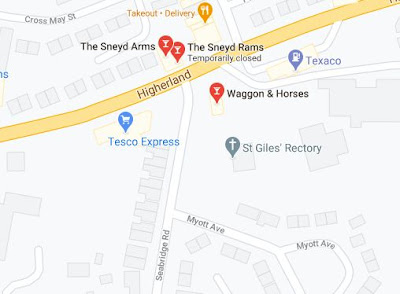While WW II was still raging, plans were already being made for post-war reconstruction. Mostly, this was concerned with planning. For housing, industry and also pubs.
The following quotes come from the chairman's (Mr. Arthur Mitchell) report and Mitchell & Butler's annual general meeting. Much of it is spent discussing the future of pubs in peacetime. There's a reason the company would have a deep interest in this topic. M & B had been very active in the "improved public house" movement between the wars. Building many so-called "roadhouses" - large pubs usually located on main roads, often in a mock Tudor style.
This is an example:
A great fear of brewers was nationalisation of their industry. A policy which had been kicked around by the Labour party.
"Nationalisation is in the air. I have given this matter very careful consideration with regard our own trade. Through the courtesy the Home Secretary, to whom I am very grateful, I was allowed to visit Carlisle, together with members of my Board and others. I congratulate the State Management Districts Council on the efforts they have made under favourable conditions put that small part of England in order as far public houses are concerned, and want to say at once that the system appears to us to very well managed. At the same time justice to ourselves I must say I found nothing that we had not already accomplished, and in several cases very much improved upon with regard to construction of the houses, catering facilities and above all the amenities on offer to our customers.
For this reason I am definitely opposed to nationalisation of the brewing trade. Private enterprise can give customers much better service in every way by the policy which we have pursued for a number of years."
Staffordshire Advertiser - Saturday 09 December 1944, page 8.
Carlisle's pubs and breweries had been nationalised during WW I. It's relative success was of great concern to brewers, as it could have been used as a blueprint for the whole country. To their relief, nothing ever came of it.
There had been a government report considering what should happen to pubs after the war.
"A most important happening this year for the Trade was the publication the Morris Committee's Report, or to give it its official title, the Report of the Committee on War Damaged Licensed Premises and Reconstruction.
This Committee was appointed to consider how the provision of licensed houses in place of those damaged or destroyed by enemy action should planned with due regard to requirements and with proposals for redevelopment and reconstruction.
The brewing trade as a whole warmly welcomed the Report, feeling that if the recommendations were implemented they would be the means of licences being redistributed simply and easily according as the needs arose in connection with new development or reconstruction.
The Bill designed to give effect to its recommendations was recently introduced in the House by the Home Secretary and is called the Licensing Planning (Temporary Provisions) Bill. This Bill appears to be an honest attempt to carry out the recommendations of the Morris report. I do not desire at this stage to attempt any detailed comment on it, but there are several points on which the language of the Bill is not so clear as we would wish, and I hope they may be satisfactorily cleared up before it becomes law."
Staffordshire Advertiser - Saturday 09 December 1944, page 8.
What was it, then, in the report that the chairman didn't like? The first was to do with the Compensation Fund. This was financed by a levy on pubs and its purpose was to compensate owners when a licence was extinguished.
"The clause which effects this change is more equitable than one contained in the recent Town and Country Planning Act which allows, in certain circumstances, the Compensation Fund provided by the Trade itself, to be raided for the purpose of public improvement."
You can see why that would piss off a pub owner.
The other was about unwanted competition from "clubs and "bottle shops" which are not subject to the same supervision and control as public houses". This a recurring theme. Brewers hated clubs, viewing them as unfair competition. They weren't keen on off-licences, either. Unless they owned them themselves.
Finally, something on the nature of post-war pubs.
"I have heard it said that customers of licensed houses liked the small, inconvenient, "hole and corner" places of the past. In my experience of the Licensed Trade, and having been in close touch with cur customers through the Company's managerial system of trading, I can honestly say this is ail "stuff and nonsense," as far as the younger generation is concerned.
The Morris Report dealt fairly exhaustively with the size of public houses of the future, and finally recommended that in general the needs of the public would be better met by a reasonable number of moderate sized, well built, well equipped houses, than by a small number of establishments of excessive dimensions, though they recognised that there is also scope for some large premises catering especially for recreation and social functions."
Staffordshire Advertiser - Saturday 09 December 1944, page 8.
Not keen on small, cosy pubs then?
Based on my own personal knowledge of post-war pubs, medium-sized is what was decided on. I can't think of an example even half the size of the roadhouse above. The right decision, I believe. I'm guessing brewers had to turn in three or four licences to be permitted to build a big roadhouse.
M & B were unusual in mostly having managers run pubs rather than tenants. That's what he means by "managerial system".
A large percentage of post-war builds were what is usually referred to as estate pubs. Pubs located in new housing developments. These could be in newly-built districts, but also regenerated inner-city areas.
They're getting to be quite rare, with many converted to shops, or simply demolished.






















































































